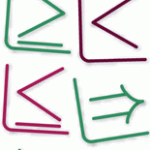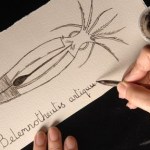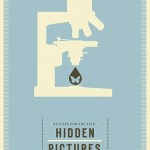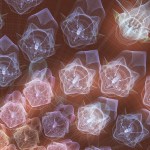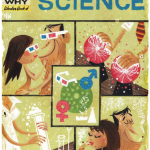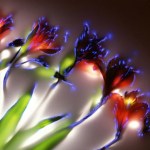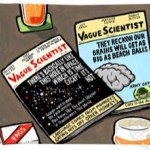Artists & Art
Science's July issue has an interesting article about mathematician Byron Cook, who teamed up with artist Tauba Auerbach to create nine new mathematical symbols. The symbols were intended to make the notation for Cook's work on a particular mathematical problem, called the "halting problem," more intelligible:
"When I was giving lectures or talking to product developers, I needed to get a lot of information across quickly, and this was getting difficult," says Cook. Things got even tougher when he began to write a book on the subject.
The article includes some interesting tidbits about the…
I'm still tickled by the British scientists who discovered a cache of ancient squid ink and used it for. . . art:
Paleontologists discovered the remains of the creature, called a Belemnotheutis antiquus, during a dig at a Victorian excavation in Trowbridge, Wilts. They cracked open what appeared to be an ordinary looking rock only to find the one-inch-long black ink sac inside. After realising what they had stumbled across, they took out a small sample of the black substance and ground it up with an ammonia solution. Remarkably, the ink they created was good enough to allow them to draw the…
An irreverent, sometimes wince-inducing, profoundly touching sampler of the ephemeral moments we take for granted:
Video by Will Hoffman and team, found via Scibling/author Jonah Lehrer.
Lovely minimalist poster design from Jordan Michael Gray's flickrstream.
via NOTCOT.
Notice--Forest (McDonald's paper bag)
Paper Bag, Glue
Yuken Teruya, 2005
Paper artist Yuken Teruya does the impossible by turning a fast food bag into a stunning sunset-dappled lone tree. The Forest Series, creating paper trees out of disposable waste products like toilet paper tubes and paper bags, is a poignant glimpse of the forest behind the paper - it's a like a little bit of the lost trees' spirit lives on in the consumer end product. Yes - even McDonald's bags were once alive!
There's also something magical about looking from the inside of the bag outwards, sneaking behind the garish…
H. annuus
Macoto Murayama
Nanobots? Alien spaceships? A scene from TRON? No, it's illustrator Macoto Muriyama's delicate diagrams of flower structure. Muriyama says,
Generally, a plant is considered to be a being that has an organic form. However, that is just one of the aspects because along with their organic form, a plant possesses a contradictory element of geometric/mechanical structure. By highlighting the later, the plant's out-of-the-ordinary form is revealed, and in it, a different kind of attractiveness can be found. (source)
See an entire gallery of Muriyama's work at Pink…
BIKES
cardboard and glue, life size
Chris Gilmore, 2003
I've been unpacking after the move, which means I'm surrounded by piles of cardboard boxes that need to be broken down and recycled. I wish I had Chris Gilmore's skill with cardboard! He sculpts machines and mechanisms, from Fiats to typewriters, entirely in quotidian corrugated cardboard and glue - materials we rarely think about and accord very little respect. Of course, these lightweight mimics don't actually function - but that makes a neat statement too, since so many of the everyday objects he sculpts are primarily functional, not…
Photographer: Rudy Huhold
Agency: Artplan
Apparently package delivery service Sedex Express is quite similar to. . . your brain on drugs. Hmmmm.
Via fubiz
Artist Emmanuel Polanco does amazing collage work reminiscent of Eduardo Recife. I especially like this piece, but he has several more with more overt vintage-science content. See a gallery at Fubiz.
Japanese artist Kawano Takeshi's 2007 rendition of global warming is simple, a little funny, and a lot sad.
For another version of the same theme - using a real child's toy - check out Ours (the Bear), a video by French artist Simon Dronet. I'll try to embed it, but the link's wonky, so you might have to click through to see it.
OursUploaded by laperitel.
Via Fubiz
R-Evolve, 2009
Jud Turner
To complement my previous entry on bikes with an anatomical inspiration, here are some bike-and-bone inspired sculptures from Jud Turner, who is currently showing work at Device Gallery in San Diego.
R-Evolve, the sculpture above, was created for a group show, Joyride, in conjunction with the Bicycle Film Festival and NYC's Anonymous Gallery.
Turner's artist statement places him squarely in the sciart camp:
Quantum physics tells us that apparently solid objects are comprised of vast empty spaces, populated by tiny particles whose individual relationships create…
Le Boson de Higgs, 2008
Korner Union
Gaussian Goat , 2008Harm van den Dorpel
Both artworks via today and tomorrow
Father Heart, 2006
Black Nickel on Rolled Steel; Glass Tank - 80cc with pedalJosh Hadar
It's always puzzled me that bicycles don't take better advantage of the gleaming potential of curvacious, polished metal. Why are most bike frames so boring and triangular? Fortunately Josh Hadar has come to the rescue, with his beautiful curved steel custom bicycles. They're all lovely, but when he adds blown glass "hearts" to their steel ribs, his bikes seem positively. . . alien. Isn't it interesting that adding elements of human anatomy makes the bikes seem more unnatural? More bikes (and the charming…
Smarthistory is a wonderfully simple concept: landmark artworks presented with conversational narration (sometimes audio, sometimes video) by Beth Harris and Steven Zucker. Sometimes they focus on a single work, as a professor would in a lecture; in other tracks, they stand in a murmur-filled gallery and comment on the hubbub around them. I have friends who sound just like Zucker and Harris when you get them talking about art - relishing the give and take of ideas; happily tossing out half-formed hypotheses about intent and context; gently mocking art cliches, curation cliches, and the (…
Check out this clever riff on vintage science books by Nate Wragg, one of a group of Pixar illustrators who teamed up to create the forthcoming Ancient Book of Sex and Science. Wragg says,
A favorite series of mine is "The How and Why Wonder Books." These were informational books that would focus on a certain subject or form of science per book. As I looked over the entire series, I thought to myself, "There is no sex and science issue." This gave me the perfect excuse to create my own volume for the series. The end result is the long lost "Sex and Science" edition that was never published.…
Do You Like My Hat?
Lori Field
Lori Field uses mixed media, including encaustic, to create collage dreamscapes inspired by medical and botanical illustrations. Apparently two-headed kittens are also a theme. See more at the artist's gallery website. Check out The Little Death and Frog Princess.
found via dr.hypercube
Alstroemeria, sp.
Robert Buelteman
One of my favorite short stories is Hawthorne's Rappaccini's Daughter, in which an eccentric, Frankensteinian botanist breeds increasingly beautiful, increasingly deadly flowers. These images from Robert Buelteman remind me of Rappaccini's garden. His creative process sure sounds like something Dr. Frankenstein might have employed:
Buelteman hits everything with an electric pulse and the electrons do a dance as they leap from the sheet metal, through the silicone and the plant (and hopefully not through him), while heading back out the jumper cables. In…
Check out these remarkable photos of patterns grown in Japanese rice fields using different strains of pigmented rice. A number of commenters on the thread at funster have suggested the photos are faked, so I found this Japanese news clip on YouTube. I like the art in the video clip even better! :)
"Vague Scientist," by the clever/hilarious Stephen Collins of coelecanth diaries
via lots of places (New Scientist, Wired, etc.)
Kurt Peterson
Artomatic just wouldn't be complete without a sinister cephalopod, and luckily Kurt Peterson stepped up to make it happen. At least I think that's a cephalopod. Unfortunately, Peterson's another one of these off-the-grid, website-free artists, but you can read a little about him at his Artomatic user page.
